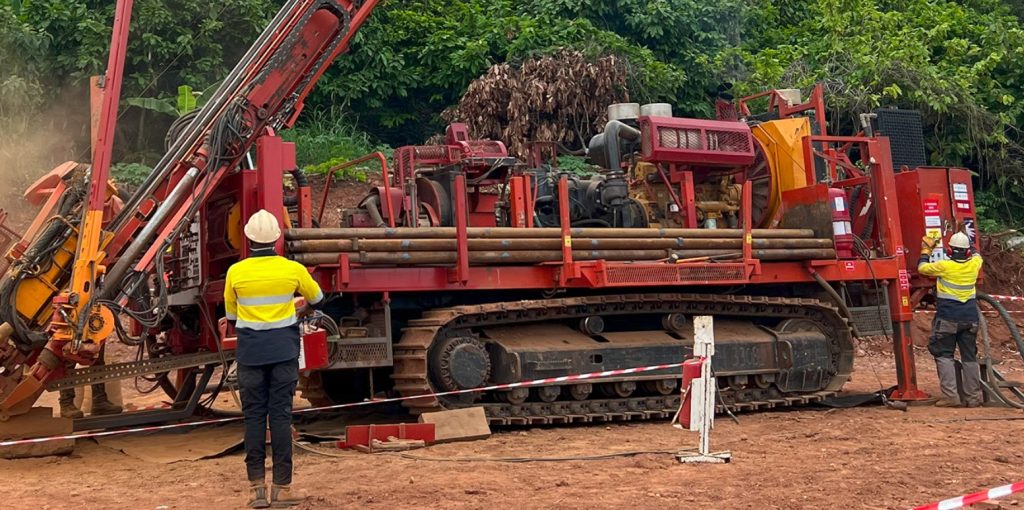Kobo Resources drills 2.1 g/t gold over 13 metre at Kossou, Ivory Coast

Kobo Resources Inc. [KRI-TSXV] has completed initial drilling at its Kossou gold project, located in Ivory Coast, West Africa, with 5,887 metres drilled in 53 reverse circulation (RC) drill holes in under five weeks. Drilling has successfully confirmed significant gold mineralization at the Road Cut zone and additional strong gold mineralization within the Jagger zone. Further exploration has elevated the Kadie zone to drill status. All drill assay results have been received and reported in this release.
Program highlights: The Road Cut zone has been drilled over a strike of 850 metres, including KRC022, returning 8 metres at 3.18 g/t gold and KRC044 returning 13 metres at 2.10 g/t gold.
The Jagger zone has been drilled over 1,400 metres strike extent with mineralization intersected in every hole and KRC015 returning 6 metres at 4.31 g/t gold, including 2 metres at 8.42 g/t gold.
Kadie zone: Strong, well-defined, gold-in-soil anomalies over a total of 750 metres combined strike extent have been elevated to drill target for next program.
Edward Gosselin, CEO and director of Kobo, commented: “Following the completion of our maiden drill program, both the Jagger zone and the Road Cut zone have yielded excellent gold results to-date. Additionally, we are now elevating the Kadie zone to drill target status as we continue to expand our detailed soil geochemical program.” He continued: “The geological team delivered these results without incident in less than five weeks, and I am extremely pleased with the performance of the entire Kobo team during the course of this program. Having identified multiple shear zones with gold mineralization, we are more convinced than ever of the project’s potential value and look forward to fully evaluating the potential of Kossou through additional work. Currently, we are reviewing all results and planning for our next drilling program, which we anticipate will commence in the fall.”
Road Cut zone: The company completed 1,699 metres of RC drilling in 13 holes and has defined broad zones of gold mineralization with high grade sections hosted within sheared and silicified volcanic units over a strike length of 850 metres. Gold mineralization has been confirmed in clearly defined zones to a depth of 80 metres below surface. There remains a gap of 500 metres between holes KRC051 (5 m at 3.27 g/t Au) and KRC044 (9 m at 2.94 g/t Au) that is underlain by a strong gold soil geochemical anomaly that remains a primary drill target for the future. See an attached table for full drill results.
Highlights: KRC022 returned eight metres at 3.18 g/t Au; KRC041 returned 10 metres at 1.33 g/t Au; KRC040 returned 12 metres at 1.49 g/t Au; KRC044 returned 13 metres at 2.10 g/t Au, including nine metres at 2.94 g/t Au and 5 metres at 4.48 g/t Au, including two metres at 10.41 g/t Au and a separate interval of 3 metres at 3.16 g/t Au; KRC051 returned five metres at 3.27 g/t Au, including two metres at 4.89 g/t Au.
Jagger zone: The company completed a total of 25 RC drill holes for 3,164 metres, mainly south of the results reported previously and has now recorded gold mineralization in drilling over a total strike extend of 1,400 metres Jagger continues to show broad zones of gold mineralization with higher grade sections within a strong north-south shear zone. Results from KRC047 and KRC048 confirmed gold mineralization 200 metres north of the previously reported results. This gap is underlain by a strong gold soil geochemical anomaly and will be targeted for future drilling.
Highlights: KRC015 returned six m at 4.31 g/t Au; KRC018 returned seven metres at 1.47 g/t Au, including 2 metres at 4.17 g/t Au; KRC047 returned six metres at 1.67 g/t Au and 5 metres at 1.01 g/t Au; KRC048 returned five metre at 1.20 g/t Au.
Recent infill soil sampling at the Kadie zone has identified three strong geochemical anomalies 200 metres, 400 metres, and 600 metres west of the main Jagger zone with individual soils sampling up to 1,620 ppb, 6,010 ppb and 1,620 ppb respectively. Recent prospecting and mapping has identified surface samples up to 7.42 g/t gold in mineralization similar to that noted in trench KTR028. The total combined strike extend of these anomalies totals approximately 750 metres.
Contact zone: Results of the two reconnaissance drill lines (15 RC drill holes for 1,024 m) failed to intersect significant gold mineralization but has identified the important contact between the metasediments and the volcanic package. The company believes there is still potential to the northwest along the contact where gold has been identified in silicified sediments and local small-scale mining has been active in the past.
An accurate dip and strike and controls of mineralization are unconfirmed at this time and the true width of mineralization is unconfirmed at this time. Drill holes are planned to intersect mineralized zones perpendicular to interpreted targets. All intercepts reported are downhole distances.
The 100%-owned Kossou Gold Project is located approximately 20 km northwest of the capital city of Yamoussoukro and is directly adjacent to one of the region’s largest gold mines with established processing facilities.
The 2023 exploration plan calls for over 8,000 metres of reverse circulation drilling with an immediate goal of defining significant near surface zones of gold mineralization.
